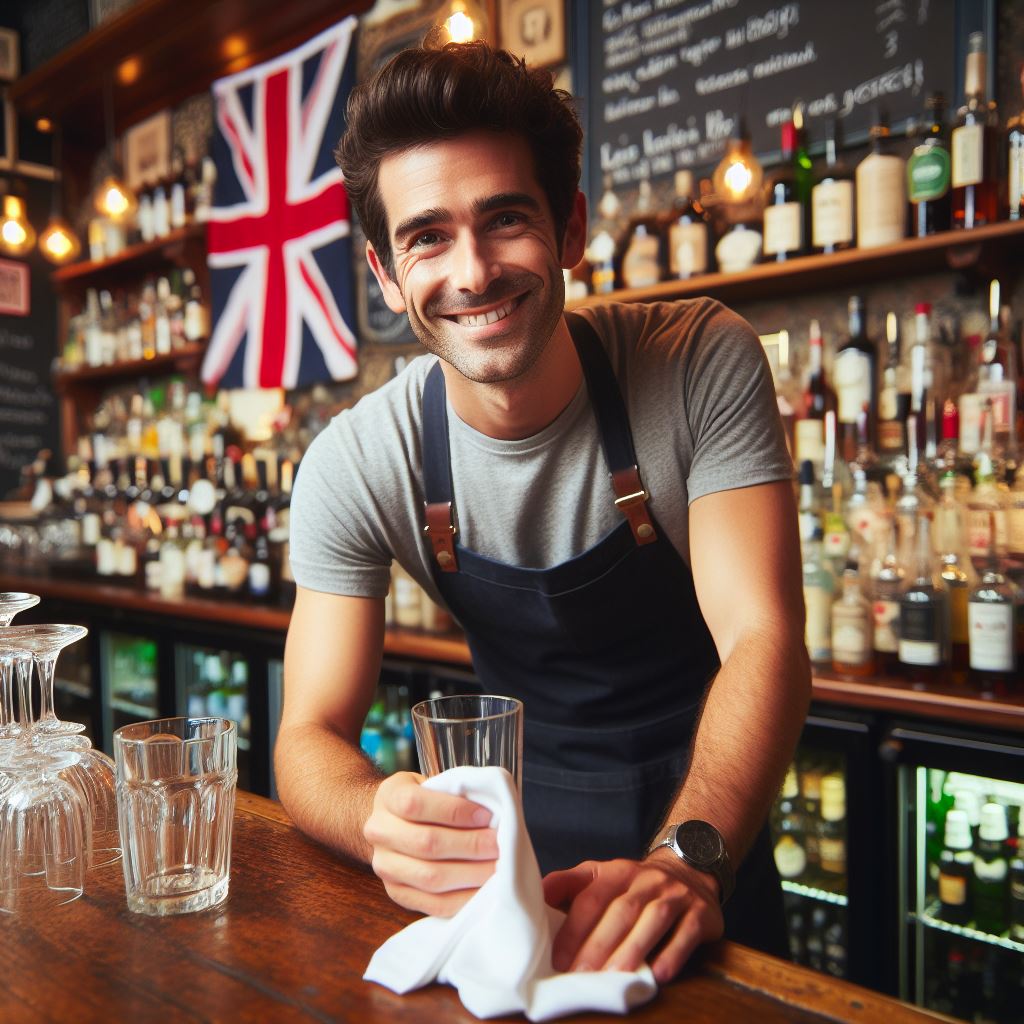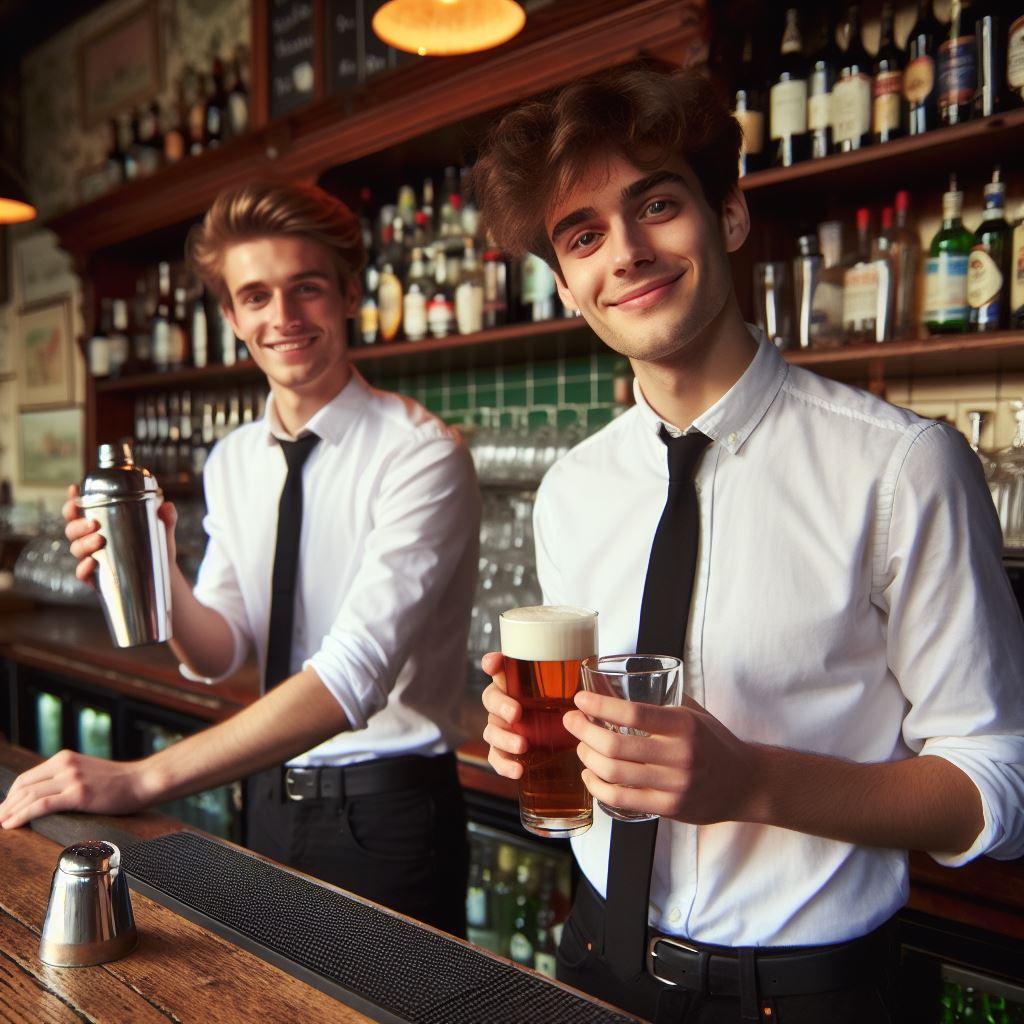Introduction
The UK bartender’s guide is essential for bartenders in the UK as it provides valuable information on tools and their uses.
Having the right bar tools is crucial for bartenders to create great-tasting cocktails and efficient service.
Step behind the bar and immerse yourself in the dynamic realm of mixology with our comprehensive “UK Bartender’s Guide: Essential Bar Tools and Uses.”
This expertly crafted guide transcends the ordinary, delving into the nuances of each tool that graces the bartending landscape.
From the iconic muddler to precision pourers, we unravel the secrets behind their design, revealing how they harmonize to create the symphony of flavors that captivate discerning palates.
Embark on a journey through the rich history of these indispensable instruments, tracing their evolution from humble beginnings to contemporary marvels.
Discover the art of muddling, shaking, and stirring as we unveil the techniques that transform raw ingredients into liquid masterpieces.
Whether you’re perfecting a classic cocktail or pushing the boundaries of mixology innovation, our guide equips you with the knowledge to navigate the diverse array of tools at your disposal.
Navigate the world of jiggers, strainers, and garnish tweezers with precision, as we demystify their roles in crafting visually stunning and palate-pleasing drinks.
Elevate your bartending journey, whether you’re shaking up a storm in a bustling city bar or curating signature drinks in an intimate lounge.
Unleash your creativity, sharpen your skills, and toast to becoming a maestro behind the bar with our unparalleled exploration of the UK’s essential bar tools and their captivating uses.
Cheers to craftsmanship, innovation, and the spirited world of bartending!
Essential Bar Tools: A Guide for UK Bartenders
The must-have bar tools for UK bartenders.
Being a bartender in the UK means having the right set of tools at your disposal.
These tools not only make your life easier but also elevate your bartending skills to new heights.
In this section, we will discuss the must-have bar tools for UK bartenders, their uses, and why they are necessary for a seamless bartending experience.
Personalized UK Career Consulting
Receive tailored career guidance designed just for you. Get actionable steps and expert support to boost your career in 1-3 days. Take control of your career now.
Get Started1. Shakers
The shaker is an essential tool that allows bartenders to mix and chill cocktails quickly.
It comes in various types such as the Boston shaker, cobbler shaker, and French shaker. Each variation offers its unique benefits.
The Boston shaker, for example, is excellent for creating a strong shake, while the cobbler shaker is more user-friendly with an integrated strainer, making it perfect for beginners.
2. Jiggers
Jiggers are measuring tools used to ensure precise pouring of spirits and other ingredients.
They come in different sizes, such as the 1-ounce/2-ounce jigger or the ½ ounce/1-ounce jigger.
Jiggers are crucial for maintaining consistency in cocktail recipes, ensuring accurate proportions in every pour.
3. Muddlers
Muddlers are essential tools for releasing the flavors of fruits, herbs, and spices in cocktails.
They are used for mashing and grinding ingredients in the bottom of a glass or shaker to extract their essence.
This tool is particularly crucial for creating popular cocktails like mojitos and old fashioneds.
4. Mixing Spoons
Mixing spoons are long and slender tools with a twisted handle, designed to efficiently mix and stir cocktails.
They are typically used for gently blending ingredients in a glass or a shaker.
Mixing spoons are invaluable for creating stirred cocktails such as martinis, negronis, and manhattans.
5. Strainers
Strainers are used to separate solid ingredients from the liquid when pouring a cocktail into a glass.
The most commonly used strainers are Hawthorne strainers and julep strainers.
Your Dream Job Starts with a Perfect CV
Get a tailored CV and cover letter that captures your unique strengths and stands out in your industry. Let us help you make an unforgettable first impression.
Get StartedHawthorne strainers feature a coil that fits snugly into the shaker or mixing glass, preventing any unwanted ice or ingredients from entering the serving glass.
Julep strainers, on the other hand, are perforated and excel at straining cocktails served over ice.
6. Citrus Zester
A citrus zester is a small tool used to remove the zest from citrus fruits. The zest contains essential oils that add a burst of flavor to cocktails.
By using a zester, bartenders can effortlessly add a citrusy twist to their creations, enhancing the overall taste and aroma.
7. Bar Blades
Bar blades are multipurpose tools used for opening bottles, cutting citrus fruits, and other quick tasks behind the bar.
They are compact and easy to handle, making them a bartender’s best friend when it comes to efficiency and convenience.
In short, these essential bar tools are not just fancy gadgets but necessities for UK bartenders.
Shakers, jiggers, muddlers, mixing spoons, strainers, citrus zesters, and bar blades each play a critical role in transforming drinks into delightful creations.
By having these tools at hand, bartenders can showcase their skills, maintain consistency, and ensure customer satisfaction.
So, equip yourself with these essentials and unlock the true potential of your bartending journey in the UK.
Read: Salary Insights: What UK Bartenders Really Earn
Shakers and Mixing Tools
When it comes to crafting delicious cocktails, having the right tools is essential.
One of the most important tools for any bartender is a shaker.
Shakers are used to mix ingredients together and create that perfect blend of flavors.
Optimize Your LinkedIn for Success
Boost your LinkedIn profile with a professional bio, keyword-rich headline, and strategic recommendations that attract recruiters. Stand out from the crowd and get noticed.
Optimize NowThere are several different types of shakers, each with its own unique purpose and use.
The different types of shakers and their uses
1. Boston Shaker
- The Boston shaker consists of two parts: a metal tin and a mixing glass.
- It is commonly used for shaking cocktails that contain citrus or fruit juices.
- The glass provides visibility, allowing the bartender to monitor the ingredients while shaking.
- It requires a firm tap to separate the two parts after shaking.
2. Cobbler Shaker
- The cobbler shaker consists of three parts: a metal tin, a lid with a built-in strainer, and a cap.
- It is easier to use for beginners as it eliminates the need for a separate strainer.
- It is ideal for shaking cocktails with less volume and those that do not require an aggressive shake.
- The cap can be used as a measuring device for precise pouring.
3. Parisian Shaker
- The Parisian shaker consists of two metal tins that fit one inside the other.
- It is commonly used by professional bartenders for its durability and versatility.
- It is ideal for shaking cocktails that require a vigorous shake to properly mix the ingredients.
- It requires a separate strainer for pouring the mixed drink into a glass.
Proper shaking techniques are crucial for achieving the desired texture, temperature, and dilution of a cocktail.
Bartenders should always ensure a tight seal between the shaker parts to avoid any leakage during shaking.
Holding the shaker with both hands and shaking it vigorously helps to emulsify the ingredients, creating a harmonious blend of flavors.
In addition to shakers, bartenders also rely on other mixing tools to create well-balanced cocktails.
Stirring spoons are commonly used when stirring ingredients directly in a glass or a mixing beaker.
They are ideal for cocktails that require a gentle blend without the introduction of air or ice splinters.
Strainers are another essential tool for bartenders. They are used to separate the liquid from solid ingredients, ice, or pulp while pouring the cocktail into a glass.
Hawthorne strainers, with their coiled springs, are widely used and help to catch solid particles, ensuring a smooth and enjoyable drinking experience.
Having a variety of bar tools, including different types of shakers, stirring spoons, and strainers, allows bartenders to experiment with different techniques and create a wide range of cocktails.
These tools not only enhance the bartender’s skills but also contribute to the overall experience and satisfaction of the guests.
So, the next time you order a cocktail, take a moment to appreciate the craftsmanship behind it and the essential bar tools that make it possible.
Read: Cocktail Recipes Every UK Bartender Should Know
Measuring and Pouring Tools
1. Types of Measuring Tools: Jiggers and Shot Glasses
In the world of bartending, precision is key. This is where measuring tools come into play.
The two most commonly used measuring tools are jiggers and shot glasses.
Jiggers, also known as bar jiggers, are small hourglass-shaped measuring devices.
They typically have two different measuring chambers, allowing for more flexibility in measurements.
The most common sizes of jiggers are 1 oz and 1.5 oz, although other variations exist.
Shot glasses, on the other hand, are cylindrical in shape and have a single measurement line.
They come in various sizes, including 1 oz, 1.5 oz, and 2 oz. Shot glasses are often used to measure spirits and other ingredients in cocktails.
Both jiggers and shot glasses are essential tools for bartenders, allowing them to accurately measure the right amount of each ingredient in a cocktail.
2. Importance of Accurate Measurements in Cocktail Making
Accurate measurements are crucial in cocktail making to ensure consistency in taste and balance.
Each ingredient plays a specific role in the overall flavor profile of a cocktail, and slight variations can significantly affect the final outcome.
Using the right amount of each ingredient is essential for achieving a well-balanced cocktail.
Whether it’s a classic recipe or a new creation, precise measurements help bartenders maintain the integrity of the drink and ensure customer satisfaction.
Moreover, accurate measurements are particularly crucial in complex recipes that involve multiple ingredients.
With precise measurements, bartenders can control the intensity of flavors and create harmonious combinations.
3. Pouring Techniques and the Significance of Consistent Pours
Pouring techniques are equally important as the measuring tools themselves.
Bartenders must master the art of pouring to guarantee consistent results every time.
One fundamental pouring technique is using the count method.
This method involves counting the number of seconds it takes to pour a specific amount of liquid.
For example, a four-count pour might mean pouring a 2 oz shot in four seconds.
Consistent pours are crucial because they ensure that customers receive the same drink, no matter who is behind the bar.
This consistency builds trust among customers and creates a reliable reputation for the establishment.
Additionally, consistent pours help manage costs by controlling the amount of alcohol and other ingredients used.
To achieve consistent pours, bartenders must practice and perfect their pouring techniques.
Regular training and practice sessions can improve accuracy and speed, resulting in more efficient service.
Measuring and pouring tools are essential for bartenders to create well-crafted cocktails.
Jiggers and shot glasses provide precise measurements, while accurate pours and consistent techniques ensure a consistent drinking experience.
Mastering these essential skills is vital for any bartender looking to excel in their craft.
In the next section, we will explore the various types of cocktail shakers and their uses in the art of mixology.
Read: The Evolution of UK Pub Culture and Bartending
Cutting and Muddling Tools
In the world of bartending, having the right tools is essential for creating perfect cocktails.
When it comes to cutting and muddling, certain tools are necessary to achieve the desired results.
Let’s take a closer look at the cutting tools for garnishes and the role of muddlers in muddled cocktails.
Cutting Tools: Knives and Peelers
When it comes to garnishes, precision is key. Bartenders need a variety of cutting tools to create beautiful and eye-catching garnishes.
Knives are the most common tools used for cutting fruits and vegetables.
They come in different shapes and sizes, each designed for specific purposes.
For example, a paring knife is perfect for peeling citrus fruits or creating intricate designs on garnishes.
A serrated knife is great for slicing through tougher-skinned fruits like lemons or pineapples.
And a chef’s knife is versatile and can be used for a wide range of cutting tasks.
Peelers are also essential tools for creating garnishes. They allow bartenders to remove the outer layer of fruits or vegetables quickly and efficiently.
Whether it’s a citrus twist or a cucumber ribbon, peelers help achieve the desired effect.
Muddlers: Essential Tools for Muddled Cocktails
Muddlers play a crucial role in creating muddled cocktails. Muddling is the process of gently crushing ingredients to release their flavors.
Muddlers are typically made of wood or stainless steel and come in different shapes and sizes.
The most common type of muddler is a pestle-style muddler, which is great for muddling fruits, herbs, and sugar cubes.
Another popular option is a flat-bottomed muddler, which is ideal for muddling delicate herbs like mint leaves.
Muddlers are essential for releasing the essential oils and flavors from ingredients like fruits, herbs, and sugar.
By gently pressing down and twisting, bartenders can extract the maximum flavor from these ingredients, enhancing the taste of the cocktail.
Tips for Handling and Maintaining Cutting and Muddling Tools
Proper handling and maintenance of cutting and muddling tools are essential for both functionality and safety.
Here are some tips to keep in mind:
- Always keep your knives and peelers sharp. Dull blades can be dangerous and also make cutting tasks more difficult
- Store your knives in a knife block or sheath to protect the blades and prevent accidents.
- Clean and dry your cutting tools immediately after use to prevent rusting.
- For muddlers, wash them thoroughly after each use and dry them properly to avoid moisture build-up.
- Inspect your tools regularly for any signs of wear and tear. Replace them if necessary to ensure optimum performance.
- Always use cutting boards when using knives to protect your countertops and prevent cross-contamination.
- When using muddlers, apply gentle pressure and avoid over-muddling, as it can release bitter flavors from certain ingredients.
By following these tips, you can ensure the longevity and effectiveness of your cutting and muddling tools, allowing you to create exceptional cocktails time and time again.
In essence, cutting and muddling tools are essential for bartenders to create visually appealing garnishes and flavorful muddled cocktails.
Knives and peelers enable precision in cutting garnishes, while muddlers play a crucial role in extracting flavors.
Proper handling and maintenance of these tools are vital for their longevity and your safety.
Read: How UK Chefs Are Embracing Fusion Food

Delve into the Subject: Cultural Sensitivity in Travel Planning
Glassware and Serving Tools
Bar tools are essential for bartenders to create and serve drinks with style and efficiency.
Among these tools, glassware and serving tools play a crucial role in enhancing the presentation and overall drinking experience.
Let’s take a closer look at the various types of glassware used in bars and their specific uses.
Types of Glassware
- Highball Glass: These tall glasses are commonly used for serving mixed drinks, such as a Gin and Tonic or a Mojito.
- Rocks Glass: Also known as an Old Fashioned glass, it is used for serving spirits like whiskey or bourbon on the rocks.
- Martini Glass: This iconic V-shaped glass is primarily used for serving classic cocktails like Martinis or Cosmopolitans.
- Wine Glass: Designed with a stem to hold, these glasses are used for serving various types of wine, allowing for proper aeration and appreciation of the aromas.
- Champagne Flute: These long, narrow glasses are perfect for serving sparkling wines and champagne, as they help preserve the carbonation and showcase the bubbles.
- Shot Glass: Small in size, shot glasses are used for serving straight spirits or measuring precise amounts of liquor for cocktail recipes.
- Pint Glass: Typically used for serving beer, these glasses come in different shapes, such as tulip, pilsner, or pint
Uses of Different Glasses
Each type of glassware serves a specific purpose and contributes to the overall drinking experience:
- Highball glass is perfect for drinks mixed with a larger quantity of non-alcoholic mixer to create a refreshing and tall beverage.
- Rocks glass is ideal for serving spirits on the rocks or cocktails that are meant to be enjoyed slowly.
- Martini glass presents cocktails in an elegant and sophisticated manner, enhancing the enjoyment of sipping on a well-crafted drink.
- Wine glasses are designed to showcase the aromas and flavors of different wines, allowing for a more pleasurable tasting experience.
- Champagne flutes help retain the carbonation and concentration of bubbles in sparkling wines, elevating the visual appeal of celebration.
- Shot glasses provide the perfect vessel for serving straight spirits, encouraging quick consumption or precise measuring for cocktails.
- Pint glasses are commonly used for serving beer, with different shapes enhancing the aroma and styles of various brews.
Other Serving Tools
In addition to glassware, bartenders also rely on various serving tools to add the finishing touches to a drink:
- Cocktail Picks or Skewers: These small sticks with decorative ends are used for garnishing cocktails with fruits, olives, or other edible embellishments.
- Straws: Essential for many mixed drinks, straws facilitate sipping and add a convenient touch, especially for tropical or layered cocktails.
In general, glassware and serving tools are vital components of a bartender’s arsenal.
By choosing the right glass for each drink and utilizing serving tools effectively, bartenders can enhance the visual appeal, aroma, and overall drinking experience for their customers.
Specialized Tools
When it comes to bartending, there are several specialized tools that UK bartenders highly rely on.
These tools not only make their job easier but also help them craft the perfect cocktails.
Unique or specialized tools that UK bartenders might need
Let’s take a closer look at some of these unique and essential tools:
1. Bar Spoons with Spiraled Stems
- Bar spoons are not your ordinary spoons – they have spiraled stems.
- These spoons are used for stirring cocktails, especially those served in tall glasses.
- The spiraled stem helps to smoothly mix the ingredients without splashing or creating excess air bubbles.
- They are essential for creating perfectly balanced cocktails with consistent flavors.
2. Citrus Juicers
- Citrus juicers are essential for bartenders who frequently use fresh citrus fruits.
- These tools efficiently extract the juice from lemons, limes, or oranges.
- Freshly squeezed citrus juice enhances the taste and aroma of cocktails, providing a vibrant and tangy flavor.
- Using a juicer ensures that every drop of juice is extracted, minimizing waste and maximizing flavor.
3. Muddlers
- Muddlers are specialized tools used for mashing or muddling ingredients like fruits, herbs, or spices.
- By pressing and twisting, muddlers extract essential oils and flavors, intensifying the taste of cocktails.
- They are primarily used for creating classic cocktails like Mojitos or Old Fashioned.
- Muddlers help release the flavors trapped in the ingredients, resulting in a more vibrant and aromatic drink.
4. Cocktail Shakers
- Cocktail shakers are iconic tools in bartending, used for mixing and chilling cocktails.
- They consist of a metal tin and a snug-fitting lid that creates a tight seal during shaking.
- Shakers are essential for creating cocktails with a perfect balance of flavors by thoroughly blending ingredients.
- The shaking action incorporates air into the mixture, giving cocktails a frothy texture and enhancing their overall presentation.
5. Jiggers
- Jiggers are measuring tools that ensure precise and consistent measurements of spirits and other ingredients.
- They come in different sizes with multiple measurements marked on each side.
- Jiggers are crucial for maintaining the desired ratios and proportions of ingredients in cocktails.
- Using jiggers prevents underpouring or overpouring, resulting in perfectly balanced and consistent cocktails.
Moreover, these specialized tools play a crucial role in the creation of specific cocktails, adding precision, consistency, and professional touch to the bartender’s craft.
UK bartenders rely on these tools to elevate their skills and deliver exceptional drinks.
Conclusion
Having essential bar tools is vital for UK bartenders to deliver exceptional service.
These tools enhance efficiency, accuracy, and the overall customer experience.
By investing in quality tools and properly maintaining them, bartenders can ensure their longevity and continued effectiveness.
Moreover, to utilize bar tools effectively, it is important to familiarize oneself with their uses and functionalities.
Regular cleaning and maintenance will keep them in optimal condition.
Additionally, staying updated with the latest bar tools and techniques can help bartenders stay ahead of the competition.
Incorporating creativity and flair while using bar tools can impress customers and enhance the overall ambiance of the bar.
Bartenders should take advantage of the versatility of tools like shakers, strainers, and muddlers to create unique and delicious cocktails.
Lastly, it is crucial for bartenders to prioritize safety when using bar tools. This includes practicing proper handling techniques and knowing the limitations of each tool.
Following these suggestions will not only improve the efficiency of bartenders but also ensure the enjoyment and satisfaction of customers.
Moreover, by consistently investing in quality tools, maintaining them properly, and utilizing them effectively, UK bartenders can excel in their craft and provide exceptional service to their customers.
The right bar tools are essential for every bartender’s success, and their wise utilization can elevate the art of mixology to new heights.
[E-Book for Sale]
500 Cutting-Edge Tech Startup Ideas for 2024 & 2025: Innovate, Create, Dominate
$19.99 • 500 Tech Startup Ideas • 62 pages
You will get inspired with 500 innovative tech startup ideas for 2024 and 2025, complete with concise descriptions to help you kickstart your entrepreneurial journey in AI, Blockchain, IoT, Fintech, and AR/VR.




